A race of plans – Samsom versus Orban – Five steps – Montenegro exodus
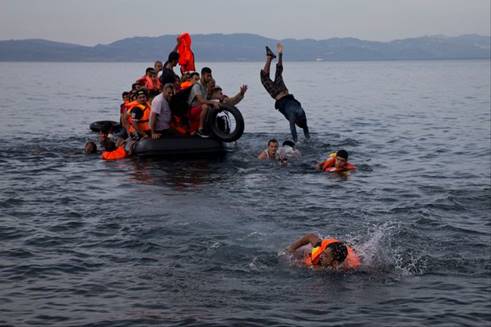

|
Dear friends,
There is a race today in Europe between two very different
concepts of how to restore control over the European Union’s external
borders.
One plan foresees the orderly large-scale resettlement of
hundreds of thousands of refugees from Turkey and an end to the Balkan
route by controlling the Aegean through close cooperation between Greece
and Turkey. Versions of this plan are backed by German chancellor Angela Merkel, although crucial details remain to be settled and negotiated.
However, there is also a radically different plan which proposes
blocking all refugee movement by constructing a new wall across the
Southern Balkans, an insurmountable fence along the green borders
between Greece and all of its northern neighbours: Macedonia, Albania
and Bulgaria. This idea is the brainchild of Hungarian prime minister
Viktor Orban, and backed by other Central European political leaders.
The decision as to which of these plans will be implemented and
backed by European institutions will have far-reaching consequences for
Greece, Balkan stability, EU relations with Turkey and the future of
refugee law around the world.
In recent weeks, ESI presented its analysis on the refugee issue in Vienna, Berlin, Brussels, Washington, Athens, Istanbul, and Munich;
we explained what it would take to implement the Merkel plan; and
argued why the Orban plan was certain to fail. It would needlessly and
unfairly antagonize Greece, destabilise the Western Balkans and create a
huge demand for readily available smuggling services. It would also
require a fence on the scale of the Iron Curtain or the Israeli fence
along its Egyptian border (which took three years to build) and the
readiness to use deadly force to have any real chance to stop those
determined and desperate enough to cross the Iranian-Turkish border or
brave the deadly Aegean.
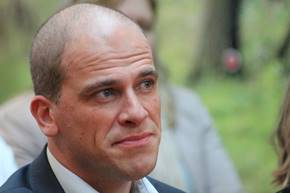 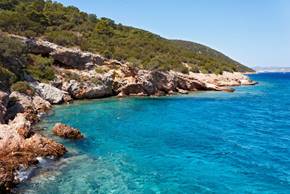 |
|
|
Diederik Samsom – Turkish Aegean
|
|
In December 2015, Diederik Samsom, the leader of the Dutch Labour
party which is a coalition partner in the current Dutch government,
travelled to the Turkish Aegean. A few weeks later he told De Volkskrant what he had learned on this trip.
First: Turkish authorities cannot stop most people leaving. In
coastal towns, Samsom met many frustrated police and border guards:
“On the beach, [the boats] are inflated quickly … Within 10
minutes they leave. The only one that can stop them is the coastguard.
But it cannot be everywhere at once. The night when I was there, twenty
boats left. We did not manage to catch even one of them. The following
day there was a picture in the newspaper of two drowned children, on one
of the beaches where I had been. For me it was clear: we do not have
years… On the Turkish coast, a kind of highway to Europe has been built.
This attracts more and more people, especially North African men. The
refugee stream will easily double.”
Second: the measures so far agreed are not going to be sufficient, Samsom told Dutch prime minister Mark Rutte upon his return.
“The height of the waves at sea determines how many people
cross, not our action plans. We need to move towards a system where the
crossing becomes pointless.”
Third: the key to any solution is the implementation of the
Greek-Turkish readmission agreement, in force for more than a decade;
this in turn requires Turkey to be a safe third country (safe for refugees) in the eyes of Greece. In this case
“The asylum request of everybody who arrives on Chios, Lesbos,
Kos or any other Greek islands is declared inadmissible because the
refugees come from Turkey, which is a safe country for refugees. They
will be returned back there by ferry.”
Fourth: for Turkey to cooperate will require moving ahead with an
ambitious resettlement programme right away, taking Syrian refugees
directly from Turkey:
“There must be a legal asylum route for a couple of hundred
thousand refugees per year. Of this I [Samsom] convinced Mark [Rutte].”
A coalition of willing EU member states will have to press ahead with this already this spring:
“At first you think: of course everyone has to contribute.
However, we did this experiment in the EU last summer with the
redistribution plan for 160,000 refugees who were already in Italy and
Greece. I remember that I thought at the time: good, those who were not
ready to cooperate were outvoted. No single country can block the
solution anymore. However, they can actually undermine it and they
managed to do so. Compulsory quotas do not work.”
Samsom stressed that Germany was ready to go ahead:
“Germany is convinced that a leading group has to step
forward, this is how the EU makes progress. Gabriel [the leader of
German Social Democrats and deputy chancellor] said to me: ‘Imagine
that we take 300,000 refugees from Turkey every year and we Germans are
the only ones crazy enough to do this – we will still be better off
than with the more than one million last year.'”
Therefore, Samsom concluded:
“I consider the chance realistic that this spring a leading
group of EU countries will have an agreement with Turkey over a legal
migration route for a couple hundred thousand refugees per year in
exchange for the direct readmission of everyone that enters via Greece.”
This is an encouraging initiative. The Samsom plan, which builds on a proposal ESI first outlined in September 2015,
is backed by a broad emerging coalition in some key EU member states.
But what needs to happen for it to produce results quickly, within the
next few weeks? As ESI found in Greece and Turkey, few concrete steps
have yet been taken or even discussed seriously.
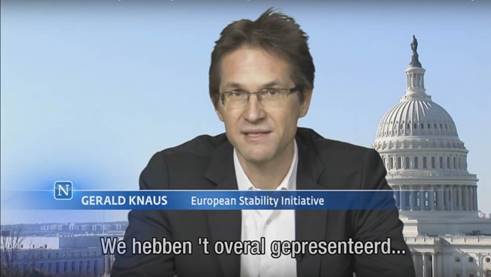 |
|
|
Explaining our proposal on Dutch news show Nieuwsuur – 28 January 2016
|
|
Here is a concrete proposal for how such a plan might make a
difference very soon, presented in recent weeks to policy makers around
Europe.
A coalition of willing EU member states, led by Germany, offers to take Syrian refugees directly from Turkey immediately. ESI
has outlined before how the selection might take place without the need
to involve either the European Commission or UNHCR as intermediaries. Transfers could begin on 1 March, with 1,000 refugees leaving Turkey by plane every day
for the next months to different countries in the EU. This would allow
fingerprinting of everyone who comes, to check personal data against
existing terrorist watch-lists and to ensure that whole families are
taken as a priority (pre-empting later debates on family unification).
It would also save lives.
Seeing refugees leave Turkey in safety and dignity, without
handing over their fate to smugglers or risking their lives on the
Aegean, would send a powerful signal to Syrian refugees. It would also
help to reassure a deeply distrustful Turkish public that Turkey is not
bearing the refugee burden alone.
This has just happened last week.
For Turkey to deserve and keep this status, it is imperative that it
fully implements its 2013 Law on Foreigners and Asylum and receives EU
support for this. More on this here.
Greece ensures that from 1 March onwards everyone who arrives in
Greece from countries with low asylum recognition rates (Morocco,
Algeria, Pakistan) needs to apply for asylum directly on the islands;
and then holds them to be returned to Turkey within days, as these
applications are found to be inadmissible due to them arriving from a
safe third country. At the same time Turkey immediately takes back
the people whose application for asylum is judged to be inadmissible by
Greece.
A working group is set up by members of the EU coalition of
willing states, as well as senior representatives of Greece, Turkey and
the European Commission. The coalition of willing states appoints a
senior political figure as chair of this group and Special
Representative to monitor and support this trilateral deal, with a small
team charged to identify and address any obstacles that emerge in
implementing this agreement and to effectively communicate it to
different key groups.
After a few weeks there is a review; as Greece and Turkey deepen their cooperation. Greece begins to declare all
asylum applications of those who come from Turkey inadmissible. While
Turkey continues to implement the readmission agreement, the European
Commission launches the legislative process to lift the visa requirement
for Turkish citizens. The resettlement of Syrian refugees from Turkey
to EU member states accelerates.
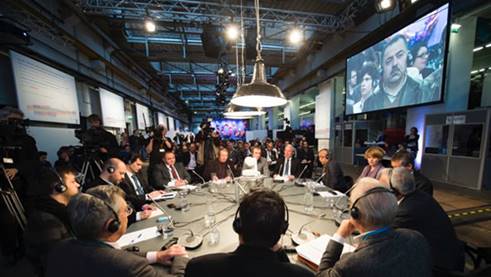 |
|
|
ESI’s Kristof Bender with mayors from Turkey, Greece and Italy in Vienna
|
|
You find more on the ideas behind the Samsom plan, its presentation and background, here:
- Rumeli Observer: The Merkel-Samsom Plan – a short history (28 January 2016)
- Rumeli Observer: Interview with Diederik Samsom, leader of the Dutch Labour party, on his plan (28 January 2016)
- Rumeli Observer: Why Amnesty is wrong on the Merkel-Samsom Plan (29 January 2016)
- Rumeli Observer: Ein Plan B für Merkel (“A plan B for Merkel”) (Süddeutsche Zeitung, 21 January 2016)
- ESI: Getting results? How muddled thinking prolongs the refugee crisis (14 December 2015)
- ESI: Berlin Initiative – Resolving the Aegean refugee crisis in early 2016 (8 December 2015)
- ESI: The devil in the details (29 November 2015).
- ESI: Turkey as a “Safe Third Country for Greece (17 October 2015)
- ESI: The Merkel Plan – A proposal for the Syrian refugee crisis (4 October 2015)
- ESI: Why people don’t need to drown in the Aegean (17 September 2015)
Media:
- EUobserver: Dutch want migrant swap deal with Turkey (28 January 2016)
- Financieele Dagblad: Nu de EU faalt moet Duitsland apart met Turkije onderhandelen over vluchtelingen (“Now that the EU fails, Germany must negotiate separately with Turkey on refugees”) (24 November 2015)
- More Media reactions to ESI’s proposal
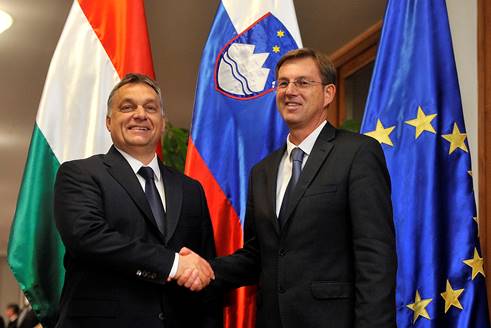 |
|
|
Viktor Orban and Miro Cerar
|
|
An alternative plan is based on a radically different approach:
to give up on Turkey and punish Greece and Turkey for their geography.
This foresees trying to close the border of Greece with Macedonia. It
includes threatening Greece that it might be kicked out of the Schengen
group if it does not find a way to stop refugees arriving in Greece.
This plan is pushed by the Hungarian prime minister Viktor Orban and
the Slovenian prime minister Miro Cerar.
For months, Orban has been arguing across Europe that the
refugee crisis was all the fault of naïve Germans, soft-hearted Swedes,
confused Austrians, incompetent Greeks and, of course, liberal social
engineers in “Brussels.”
Already in September 2015, ESI noted that, for Orban, the refugee crisis was above all a political opportunity. Back then, he argued in a speech to his party:
“there is something which fundamentalists might call a crusade, but
which moderates like me would rather describe as a challenge posed by
the problem of ‘the Islamization of Europe’. Someone somewhere must
reveal this for what it is, must halt it, and must replace it with
another, counteractive policy.”
And yet, this alleged crusade was an opportunity for him and his party, Fidesz:
“If we step back from the whole issue and its specific features and conceptually reflect on what is happening, then we see that we have a huge opportunity, if we fight well in this debate, to restore the prestige and appeal of national identity and Christian identity, in opposition to the liberal identity.”
“My position is that what we are experiencing now is the end of an era:
a conceptual-ideological era. Putting pretension aside, we can simply
call this the era of liberal babble. This era is now at an end, and this
situation both carries a huge risk and offers a new opportunity… Today
liberals dominate Europe; make no mistake, the conservatives in Europe
today are also liberals …”
See also: ESI Refugees as a means to an end – The EU’s most dangerous man (24 September 2015)
Since then, Orban has repeated this message everywhere in an
effort to construct a broad illiberal coalition and isolate Angela
Merkel in the EU. In a speech in the Hungarian parliament on 16 November 2015,
three days after terrorist attacks in Paris, Orban warned that Europe
was led by irresponsible leaders who wilfully put the lives of their
citizens at risk:
“Let us ask a simple question. What is more humane? We
Hungarians have been advocating the closure of our borders to stop the
flood of people coming from the Middle East and Africa. We have been
fiercely criticised for this, by those who claim that this is not a
humane approach. But we are faced with a question. Which approach is
more humane: to close the borders in order to stop illegal immigration,
or to put at risk the lives of innocent European citizens? The right to life takes precedence over all other rights, as does the right to self-defence.
Whichever way we look at it, the EU is rudderless. It is weak,
uncertain and paralysed. There are meetings and conferences galore, but
there are no solutions.
In Brussels they are still claiming that immigration is a good
thing. Meanwhile, day after day we see evidence that immigration is a
bad thing. It is not a win-win situation, but lose-lose.”
Orban restated his total opposition to any distribution of refugees in the EU, as this would “spread terrorism across Europe”:
“Mandatory resettlement quotas are quite simply not European:
they are a complete contradiction of the spirit of Europe. They are
pointless, because they do not resolve the crisis, but aggravate it. It
is clear that mandatory resettlement quotas do not keep migrants away,
but are more of an invitation for them. They do not reduce pressure, but
add to it – and the rapidly escalating pressure will cause European
counties to reinstate their borders within the EU.
In the light of the terrorist attacks, Brussels can no longer
question Member States’ right to defend themselves, given that mandatory
resettlement quotas are dangerous, because they would spread terrorism
across Europe.”
Throughout early 2016 he repeated these messages. In an interview with pro-government Hungarian Times
Orban explained that his position on refugees is more moral than that
of his critics and of the “West” which also support “same-sex
marriage”:
“[Journalist] You mentioned the united stance which the Visegrád
countries have taken on the migration crisis. It was quite instructive
to see how the West – which had been constantly preaching about
“solidarity” – responded to this true manifestation of solidarity, which
was not merely based on empty words.
[Orban] One of the reasons is frustration. Central Europe is
successful. At present this region accounts for the majority of
European growth… There is a dividing line which starts at the Baltic
States, and runs all the way through Poland, the Czech Republic,
Slovakia, Hungary and the western border of Slovenia. West of this line
there are countries which have long since given up on protecting
families, but East of this line we all have family-friendly policies,
and same-sex marriage is not accepted in any of these countries. In
this part of Europe everyone also understands that we cannot let in
masses of people whose true identity and intentions are unknown.”
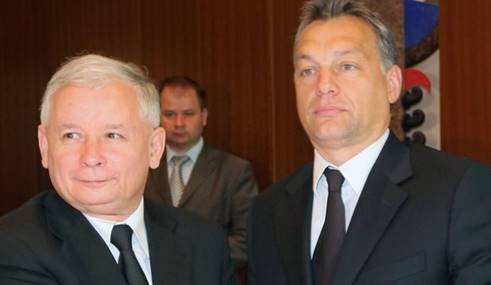 |
|
|
Two allies: Kaczynski and Orban in early 2016
|
|
On 6 January, Orban had a six-hour private meeting with Jaroslaw
Kaczynski, the leader of Poland’s ruling Law and Justice (PiS) party.
He defended the new Polish government against criticism:
“Brussels is irritated when there are strong nation states which speak
their minds, he said. This ‘provokes Pavlovian responses from European
bureaucrats’, he added. In his view Central Europe is not in any way
behind the Western half of the continent in terms of democratic norms …
today freedom of the press is much wider and deeper, much more diverse
in Central Europe than in many Western European countries.”
Orban called for efforts to “stop, not slow down” the arrival of refugees in the EU:
“Recently the Germans have said that the flow of immigrants
must be slowed down. We should not forget that nowadays around one
hundred thousand illegal migrants are arriving in the territory of
Europe every month … Fences and defence lines should not have been
erected within the Schengen Area and within Europe, but on the external
border of the Schengen Area – as Hungary has done … It is a fine thing
that the Turks have promised that there will be a line of defence there,
but using our own resources we must build a new European line of
defence one country further in: on the northern border of Greece. And
that is where we must stop – not just slow down, but stop –
immigration.”
On a trip to Slovenia on 22 January Orban again pushed his prefered solution, to trap migrants in Greece by building a wall alongside the Macedonian border.
“At a press conference held after the meeting between the
Hungarian and Slovenian governments – which lasted much longer than
planned and mostly concerned the positions of the two states related to
migration – the Hungarian Prime Minister stressed that the Hungarian
government is committed to supporting Slovenia’s initiative to achieve
international cooperation on the construction of a second line of
defence on the northern borders of Greece.”
How would this work? Orban and his allies oppose the Dublin
system. He is also opposed to any internal relocation of refugees inside
the EU. He expects instead that some of Europe’s weakest states –
Macedonia and Albania – will be able to stop a movement of people which
richer EU members have not been able or willing to do; and this in a
sensitive post-conflict region known for porous borders. After all,
Hungary itself did not stop the refugees either; it merely redirected
the flows towards its neighbours.
And yet: not only Miro Cerar, the Slovenian prime minister
picked up on the idea, but also Jean-Claude Juncker, the head of the
European Commission indicated his support. “I welcome your suggestion,”
Juncker wrote to Slovenia’s Prime Minister Miro Cerar, assuring him of
the Commission’s support for his plan for all EU countries to “provide
assistance to the Former Yugoslav Republic of Macedonia authorities to
support controls on the border with Greece through the secondment of
police/law enforcement officers, and the provision of equipment.” And
thus a plan that was Orban’s in all but name is becoming mainstream.
This is not a realistic proposal. But then again, when these
states fail, Orban can simply blame them for their lack of ruthlessness
and determination. Politically, Orban – unlike the Balkan states and
the European Commission – has nothing to lose.
For more on the future of EU refugee policy and ESI research and
advocacy on this issue – including a forthcoming analysis of what fences
can and cannot do in the Balkans – you can also follow us on twitter or
visit our website: www.esiweb.org/refugees:
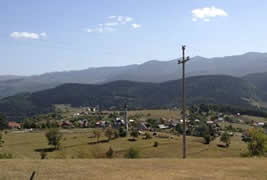 |
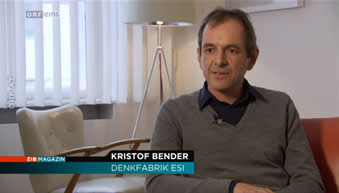 |
|
|
Rozaje – Kristof Bender
|
||
Based on research carried out in North Montenegro in 2015 by ESI deputy chairman Kristof Bender and ESI fellow Bilsana Bibic we are happy to publish the next essay in our series Return to Europe – revisited, funded by ERSTE Stiftung in Vienna.
We set out to understand why in 2015 more than 4,000 people from
Montenegro applied for asylum in the EU, as part of a wider Balkan
trend. The number of asylum seekers from five Western Balkan countries
went up from below 10,000 in 2009 to 125,000 in 2015. An
ever-increasing share went to Germany: 14 percent of the total in 2009,
but 85 percent in 2015. In June 2015, tiny Montenegro made it into the
top-10 countries of asylum seekers in Germany. What were the reasons?
“In May 2015 Halima, a 43 year-old single mother, her sister Emina
(47), her brother Hajradin (55), and two of their children (4 and 17)
left Montenegro. They did not go as tourists, or to look for work; they
left to apply for political asylum in Germany. The fact that 99.8
percent of Montenegrin applications for asylum are rejected in Germany
did not deter them. Hajradin even sold a cow and a calf to pay for it.
The small group boarded a bus in the provincial town of Rozaje
in the north of Montenegro – one of its poorest areas. There are many
buses a week leaving to Germany from here, some going directly to
Hanover, a preferred destination. Tickets for the 30-hour trip cost
around 120 euros per person. They crossed the border into the EU with
their regular biometric passports; since 2009 Montenegrin citizens do
not need a visa to travel to the EU. In Hanover, they changed buses to
reach the university town of Braunschweig. There were no traffickers
involved, no illegality and no fraud. In Germany, anybody – whether from
Syria, Montenegro or Poland – can file an asylum application at the
Federal Office for Migration and Refugees. People are then referred to a
reception centre. An official German brochure explains what happens
next: “The reception centre provides accommodation for them, takes care
of their needs and informs the closest branch of the Federal Office.”
In 2015, many Montenegrins went directly to the Braunschweig
reception centre; when an NGO visited it in June it met hundreds of
people from northern Montenegro. There, Halima and her relatives filled
out a form. They provided personal data and fingerprints. They did not
have to explain then why they applied for asylum (they did this in an
interview a few weeks later, referring to their desperate economic
situation). They spent the first three days in the reception centre,
before being taken to a hostel. Two weeks later, they were assigned a
house in a village near Bremen. A social worker visited them regularly
to see how they were doing; there were bikes provided for them to move
around. In late August, they were allocated a house with two floors in a
small town closer to a kindergarten for Halima’s daughter. “It is
equipped with modern household appliances and there is even a garden,”
they told relatives in their village. In addition to free housing and
health care, the five receive a total of € 1,290 per month. This is more
than five times the monthly salary in the private sector in their
municipality. It means even more for them; in their village, almost
nobody has a job and many households do not get any social aid.”
For more on this story, economic and social conditions in the
rural Western Balkans today, and challenges for Germany asylum policy,
please read Montenegro: Germany’s Balkan stipends – Asylum and the Rozaje exodus.
Many best regards,
- The Merkel-Samsom Plan – www.esiweb.org/refugees
- Return to Europe Revisited essays:
- Romania: Timisoara 2.0
- Kosovo: Of Patriarchs and Rebels
- Turkey: Kafka’s World and the Trial of Mehmet O.
- Bulgaria: Transition and happiness – a Bulgarian paradox?
- Greece: The good news from Greece – Can Thessaloniki point the way?
- Montenegro: Germany’s Balkan stipends – Asylum and the Rozaje exodus
- Kristof Bender on Twitter @kristofbender

 Ακολουθήστε το
Ακολουθήστε το